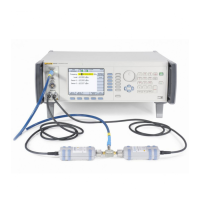Performance Tests
Performance Test 3
3-27
Making these precision low-level measurements requires
appropriate choice of Measuring Receiver settings to provide
adequate linearity, noise floor, and reading repeatability throughout
the amplitude range required. For any given frequency, the
Measuring Receiver settings must be maintained for all amplitudes
at that frequency after establishing the reference point. In particular,
receiver attenuator, reference level, and resolution bandwidth
settings must not change.
29. On the UUT, enable the REF FREQUENCY OUTPUT at 10 MHz and set the
UUT as follows:
Frequency 100 kHz
Level -37 dBm
Output OPER
30. Allow the Measuring Receiver to tune the input signal, and then set the
controls to measure RF level, relative (dB) to the current input level.
31. Without changing any Measuring Receiver settings, set the UUT to the next
amplitude listed in part A of Table 3-13 for this frequency. Allow the
Measuring Receiver reading to stabilize and record the reading as P
rel
. (Note
that P
rel
will be a negative number in dB).
32. Calculate the UUT output P
out
= P
-37
+ P
rel
. Check that the value of P
out
is
within the tolerance shown in Table 3-13.
33. Repeat steps 31 and 32 for each amplitude listed in part A of Table 3-13 for
this frequency.
34. Return the UUT output to -37 dBm, set the UUT frequency to the next
frequency listed in part A of Table 3-13, and repeat steps 30 through 34.
35. Set the UUT to 100 kHz at -75 dBm. Repeat steps 30 through 35 for the
points listed in part B of Table 3-13 using the calculation P
out
= P
-75
+ P
rel
in
step 32.
36. Set the UUT to STBY.

